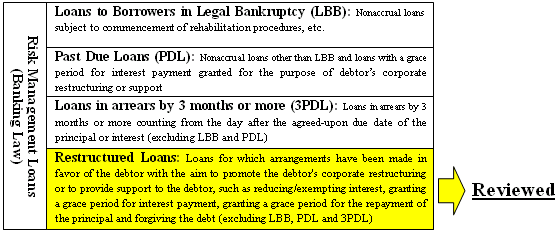In the ''Comprehensive Guideline for Supervision of Major Banks, etc.,'' which was
laid down and released to the public on October 28, 2005, the Financial Services
Agency (FSA) addressed the interpretation of the Enforcement Regulations of the
Banking Law regarding restructured loans by clearly defining: (1) the purpose
of corporate restructuring and support; (2) the provisions for the method of
setting the basic rate of interest, etc.; and (3) other interpretations. In
conjunction with this, the FSA compiled the questions and queries received from
the parties concerned in the said provisions in the form of FAQ and released it
to the public under the title ''FAQ: Restructured Loans'' on the same date.A
restructured loan is a type of non-performing loan (risk management loan) set
forth in the Enforcement Regulations of the Banking Law. In paragraph 1-5-b
(4) of Article 19-2 of the said Enforcement Regulations, it is defined as ''a
loan for which arrangements have been made in favor of the debtor with the aim
to promote the debtor's corporate restructuring or to provide support to the
debtor, such as reducing/exempting interest, granting a grace period for
interest payment, granting a grace period for the repayment of the principal and
forgiving the debt.''
After the said provisions came into force in December 1998, the ''Operational
Guidelines No.1: Deposit-taking Financial Institutions'' was revised at the end
of March 1999, which defined ''loans with reduced or exempted interest,'' ''loans
with a grace period for interest payment,'' ''loans with a grace period for the
repayment of the principal,'' etc. as examples of ''arrangements made in favor of
the debtor'' and clearly defined the disclosure criteria.
This was followed by the establishment of the Industrial Revitalization
Corporation of Japan (IRCJ) in May 2003. This triggered the revision of the
aforementioned Guidelines, which further clarified the disclosure criteria,
aimed at improving the predictability of the parties concerned in corporate
revival. Specifically, the basic rate of interest was introduced to serve as the
criteria for determining and graduating restructured loans, and provisions were
laid down to enable IRCJ and other parties concerned in corporate revival to
improve the predictability of the upgrade from restructured loans.
Under the revised Guideline at the time, the basic rate of interest was defined
as ''the actual lending rate for new loans normally applied to debtors with a
similar credit risk as the debtor concerned'' which ''should be set according to
economic rationality''. However, the interpretation of such ''economic
rationality'' was not clear at the level of the operational Guideline. As it was
generally understood and widely accepted that the effective lending rate must
''not be set arbitrarily but must be rationally and objectively demonstrable that
returns commensurate with credit risks are ensured,'' there were some cases where
the theoretical value for each individual loan was calculated based on
uniquely-established methods and was used as the basic rate of interest, which
substantially differed from the ''the effective lending rate for new loans
normally applied''.
In consideration of the practical problems and other issues that arose from
such not-necessarily-clearly-defined criteria, the FSA decided to review the
provisions for restructured loans in general, including clearly defining the
method of setting the basic rate of interest, and to publish FAQ on the topic
under the title ''FAQ: Restructured Loans'', following the recent formulation of
the ''Comprehensive Guideline for Supervision of Major Banks, etc.'' The FAQ
explains the gist of the latest revision, how the revised provisions will be
applied to small- and medium-sized and regional financial institutions, the
timing at which the revised provisions will be applied, and the details
regarding the implementation of the clarified provisions.
The following is a summary of the revision of the provisions for restructured
loans. |
![[Number of Cases of Inappropriate Non-payment]](12/2_01.gif)
![[Ratio of Inappropriate Non-payment Cases to Total Number of Non-payment Cases]](12/2_02.gif)
![[Breakdown of Inappropriate Non-payment of Insurance Money]](12/2_03.gif)
![[Breakdown of Inappropriate Non-payment of Benefits]](12/2_04.gif)
![[Annual Trends in Inappropriate Non-payment]](12/2_05.gif)
